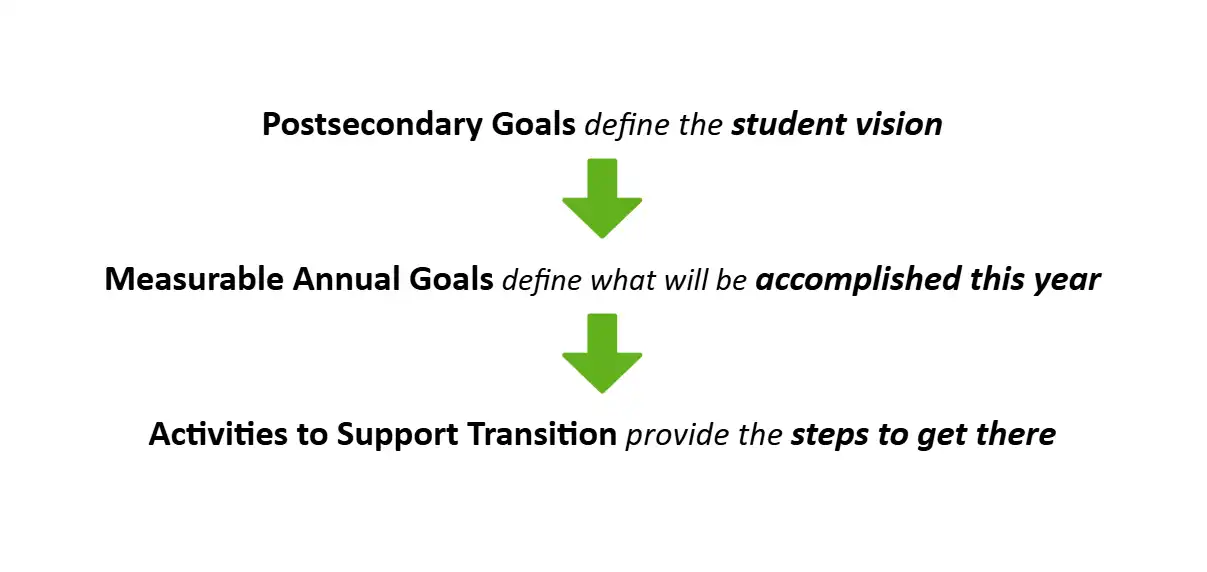Education and Training

“Student Vision”
Example Postsecondary Education or Training Goals
“Student Vision”
“Student Vision”
General Examples:
- After graduation, [Student] will enroll in a two-year college to study automotive technology.
- After completing high school, [Student] will participate in a vocational training program to become a certified nursing assistant (CNA).
- Upon exiting high school, [Student] will attend a technical college to obtain certification in culinary arts.
Extensive Support Needs Examples:
- After graduation, [Student] will attend a community-based transition program to develop functional academic and life skills.
- Following high school, [Student] will participate in supported vocational training focused on retail tasks through a local adult agency.
- Upon exiting high school, [Student] will attend a day program that includes structured training in communication and daily living.
“What they will accomplish this year”
Example Measurable Annual IEP Goals
“What they will accomplish this year”
“What they will accomplish this year”
Sample Education Goals:
- By the end of the school year, [Student] will identify 3 college or vocational training programs that match their interests with 80% accuracy, using a graphic organizer with teacher support.
- [Student] will complete a FAFSA or other financial aid application with 1:1 adult support by March of the school year.
- [Student] will demonstrate the ability to request academic accommodations using a script or AAC device in at least 2 mock settings by the end of the semester.
Extensive Support Needs Education Goals:
- [Student] will follow a visual schedule to transition between at least 3 academic activities independently in 4 out of 5 opportunities.
- [Student] will use an AAC device to express preferences during at least 2 learning activities per day.
- With hand-over-hand assistance fading to verbal cues, [Student] will match printed environmental words (e.g., "exit," "bathroom," "stop") to real-world signs in 4 out of 5 trials.
“Steps to get there”
Activities to Support Transition: Education
“Steps to get there”
“Steps to get there”
Opportunities to take the Community College Accuplacer will be provided to the student by his case manager.
Counseling office will provide support and information re: FAFSA college admissions, and campus information.
Staff will facilitate a linkage with the Student Services Office at (NAME’s) selected college.
Staff will provide academic and organizational support through learning strategies class.
Student will be provided opportunities to attend college fairs.
Staff will assist (NAME) with trade school application.
Team will facilitate linkage with Vocational Rehabilitation counselor to discuss training resources and assistance.
Instruction in practical math application and self-advocacy will be provided by staff.
The case manager will meet with (NAME) to review STAR results to help her better understand her current academic skills and how to those skills my impact future educational options.
Case manager will visit local colleges or vocational schools to explore options and services.
Staff will help students understand and connect with disability support services in postsecondary settings.
Staff will encourage students to speak up for their needs and understand their rights.
Staff will introduce tools that support learning, such as text-to-speech or organization apps.
Staff will provide step-by-step support for completing college and aid applications.
Parent and staff will use hands-on materials (coins, dollar bills) and role-playing to simulate purchasing items.
Staff will teach time awareness using personalized visual schedules and digital or tactile timers.
Staff will support practice with reading environmental print (e.g., signs, menus, labels) and using adapted texts.
Staff will teach students how to navigate communication or educational apps (e.g., Proloquo2Go, Book Creator).
Student will create simple digital or visual boards about the student’s likes, needs, and goals.
Role-Playing Scenarios: Practice expressing choices, asking for help, or declining activities using scripted prompts or AAC.
IEP Participation: Support students in communicating a preference or goal in their IEP meetings using visuals or simple language.
